Lava Xolo X900 Review - The First Intel Medfield Phone
by Brian Klug on April 25, 2012 6:00 AM ESTFor Intel, the road to their first real competitive smartphone SoC has been a long one. Shortly after joining AnandTech and beginning this journey writing about both smartphones and the SoC space, I remember hopping on a call with Anand and some Intel folks to talk about Moorestown. While we never did see Moorestown in a smartphone, we did see it in a few tablets, and even looked at performance in an OpenPeak Tablet at IDF 2011. Back then performance was more than competitive against the single core Cortex A8s in a number of other devices, but power profile, lack of ISP, video encode, decode, or PoP LPDDR2 support, and the number of discrete packages required to implement Moorestown, made it impossible to build a smartphone around. While Moorestown was never the success that Intel was hoping for, it paved the way for something that finally brings x86 both down to a place on the power-performance curve that until now has been dominated by ARM-powered SoCs, and includes all the things hanging off the edges that you need (ISP, encode, decode, integrated memory controller, etc), and it’s called Medfield. With Medfield, Intel finally has a real, bona fide SoC that is already in a number of devices shipping before the end of 2012.
In both an attempt to prove that its Medfield platform is competitive enough to ship in actual smartphones, and speed up the process of getting the platform to market, Intel created its own smartphone Form Factor Reference Design (FFRD). While the act of making a reference device is wholly unsurprising since it’s analogous to Qualcomm’s MSM MDPs or even TI’s OMAP Blaze MDP, what is surprising is its polish and aim. We’ve seen and talked about the FFRD a number of times before, including our first glimpse at IDF 2011 and numerous times since then. Led by Mike Bell (of Apple and Palm, formerly), a team at Intel with the mandate of making a smartphone around Medfield created a highly polished device as both a demonstration platform for OEM customers and for sale directly to the customer through participating carriers. This FFRD has served as the basis for the first Medfield smartphones that will (and already are) shipping this year, including the Orange Santa Clara, Lenovo K800, and the device we’re looking at today, the Lava Xolo X900. Future Medfield-based devices will deviate from the FFRD design (like the upcoming Motorola device), but will still be based loosely on the whole Medfield platform. For now, in the form of the X900 we’re basically looking at the FFRD with almost no adulteration from carriers or other OEMs.
The purpose and scope of this review is ambitious and really covers two things - both an overview of Intel’s Medfield platform built around the Atom Z2460 Penwell SoC, and a review of the Xolo X900 smartphone FFRD derivative itself.
The Device
Beginning April 23rd, Intel, through Lava International, began selling the Xolo X900 smartphone in India for INR 22000 (~$420 USD). As we’ve stated before, the design and construction of the Xolo X900 almost identically mirrors the Intel FFRD we’ve seen before, from the specifications and Medfield platform itself, to industrial design and exterior buttons.
It’s a testament to the polish of the reference design that Mike Bell’s team put together that Intel is confident enough to basically sell exactly that device through carrier partners. I’ll admit I was skeptical upon hearing that Intel would basically be selling their MDP to customers, but the device’s fit and polish exceeded my expectations and are clearly those of something ready for customer abuse. First up are the X900 specifications in our regular table (below), Xolo also has its own nicely presented specifications page for the X900 online.
| Physical Comparison | ||||
| Apple iPhone 4S | Samsung Galaxy S 2 | Samsung Galaxy Nexus (GSM/UMTS) | Lava Xolo X900 | |
| Height | 115.2 mm (4.5") | 125.3 mm (4.93") | 135.5 mm (5.33") | 123 mm (4.84") |
| Width | 58.6 mm (2.31") | 66.1 mm (2.60") | 67.94 mm (2.67) | 63 mm (2.48") |
| Depth | 9.3 mm ( 0.37") | 8.49 mm (0.33") | 8.94 mm (0.35") | 10.99 mm (0.43") |
| Weight | 140 g (4.9 oz) | 115 g (4.06 oz) | 135 g (4.8 oz) | 127 g (4.5 oz) |
| CPU | Apple A5 @ ~800MHz Dual Core Cortex A9 | 1.2 GHz Exynos 4210 Dual Core Cortex A9 | 1.2 GHz Dual Core Cortex-A9 OMAP 4460 | 1.6 GHz Intel Atom Z2460 with HT (1C2T) |
| GPU | PowerVR SGX 543MP2 | ARM Mali-400 | PowerVR SGX 540 @ 304 MHz | PowerVR SGX 540 @ 400 MHz |
| RAM | 512MB LPDDR2-800 | 1 GB LPDDR2 | 1 GB LPDDR2 | 1 GB LPDDR2 @ 400 MHz |
| NAND | 16GB, 32GB or 64GB integrated | 16 GB NAND with up to 32 GB microSD | 16/32 GB NAND | 16 GB NAND |
| Camera | 8 MP with LED Flash + Front Facing Camera | 8 MP AF/LED flash, 2 MP front facing | 5 MP with AF/LED Flash, 1080p30 video recording, 1.3 MP front facing | 8 MP with AF/LED Flash, 1080p30 video recording, 1.3 MP front facing |
| Screen | 3.5" 640 x 960 LED backlit LCD | 4.27" 800 x 480 SAMOLED+ | 4.65" 1280x720 SAMOLED HD | 4.03" 1024x600 LED backlit LCD |
| Battery | Internal 5.3 Whr | Removable 6.11 Whr | Removable 6.48 Whr | Internal 5.4 Whr |
It’s interesting to me that Intel, Qualcomm, and others identified and went with WSVGA (1024x600) for their reference designs in roughly the same 4" size. It’s a display form factor that corresponds almost exactly to 300 PPI, and looks great, but more on that later. The rest of the X900 is basically what you’d expect for a smartphone of this generation, and on par with the Android competition that Intel was targeting, perhaps minus microSD expansion.
The design language of the X900 (and Intel FFRD) is a pretty obvious nod to the iPhone 4/4S design, complete with chrome ring, similar button placement, and a few other things. Likewise, the X900 uses a microSIM whose tray is located on the right side and makes use of an ejector port and tool. Below that is the X900’s two-stage camera button, and then speaker port. There’s a matching speaker port on the other side in the same area.
MicroUSB is located at the very bottom slightly off center, and microHDMI is on the left side. Up at the top is power/standby and the standard headphone jack. There’s no real surprises here, and despite being entirely plastic-clad, the X900 feels pretty decent in the hand.
The backside is a soft touch material which we’ve seen and felt on countless other smartphones before. The only downside to the X900 design is lack of a user replaceable battery - the backside is permanently attached. At the top is the 8 MP camera port, adjacent LED flash, and secondary microphone for noise suppression.
The front of the X900 is likewise pretty standard fare - up top are the 1.3 MP front facing camera, speaker grille, ambient light sensor, and proximity sensor. At the bottom are the four Android capacitive buttons whose design mirrors the FFRD we’ve seen before.
Again there’s nothing super crazy about the design or construction of the X900, it’s an extremely polished reference design turned consumer electronic that feels solid and ready for use as a daily driver if you’re up for it. Enough about the superficial stuff though, let’s talk about what everyone wants to know about - Medfield and Android on x86.


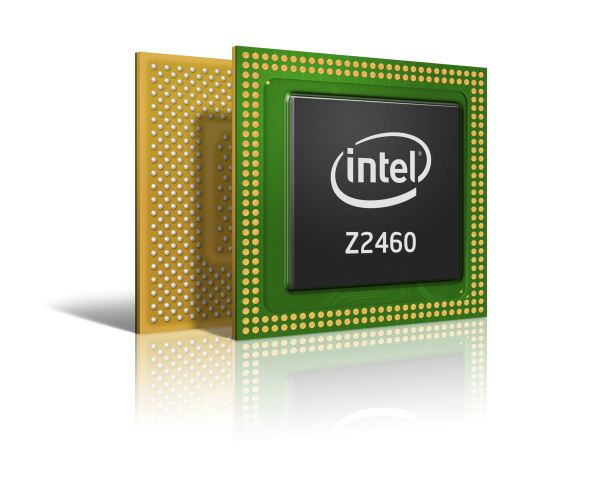
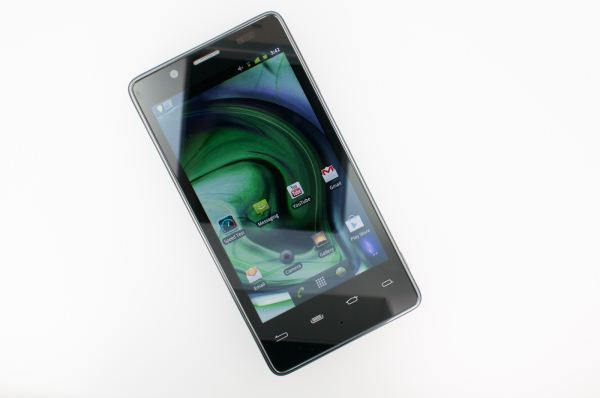
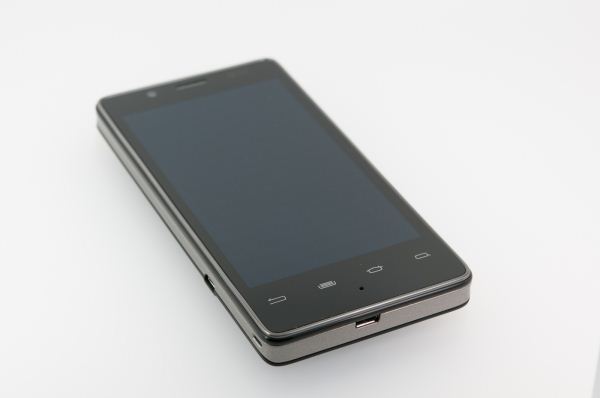
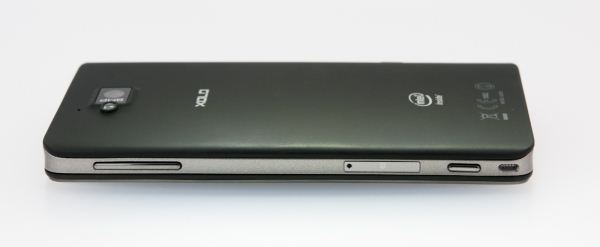
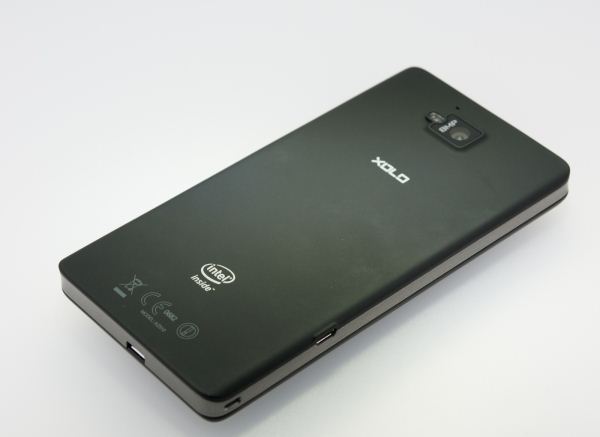
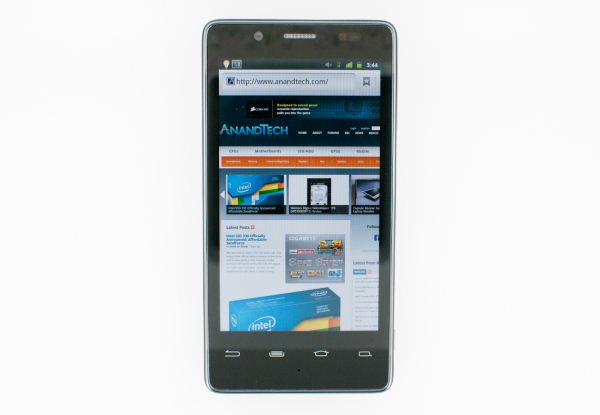














106 Comments
View All Comments
jed22281 - Thursday, April 26, 2012 - link
Vanilla MeeGo is nothing like MeeGo-Harmattan (aka Maemo6x) on the N9...The only relation Tizen has with Vanilla MeeGo, is that it's structured/administered in a similar fashion.
Plus many of the same partners involved in MeeGo, have moved to Tizen...
The developmental libraries/environment is totally different, although there's still some tacit support for Qt.
MeR+Nemo (& other UX's e.g. Cordia/Plasma etc) is what has supplanted the original MeeGo.
And yes you could in theory run MeR+Nemo or Tizen on this or other Medfied devices.
But I'm not so sure they'd necessarily be any less locked down than ARM-based ones.
Locked boot loader etc... But once that's out of the way, they'd have their advantages.
ironargonaut - Wednesday, April 25, 2012 - link
From what I see the only phones that best Intel in performance are not on the battery chart.If a phone computes something faster, will that not mean it can do more in less time? Thus, while the artificial surfing battery time is "average", wouldn't I be able to surf more pages and run more apps also in that same time period?
What is the power/performance metric?
fm123 - Thursday, April 26, 2012 - link
There is no clear way to tell from this, given that the CPU is likely ramping up and down. The other phones are not listed, I suspect, as they are new. They actually include newer battery saving features, so you can't see that yet on this comparison.ironargonaut - Thursday, April 26, 2012 - link
So,then could I safely say, that since battery life is not listed here, of the phones in both tests Intel has the highest cpu performance with midrange battery life.If they are not going to test the batteries of the same phones then you shouldn't have them listed on the same graph for CPU power. IMHO
It's like a Ford commercial saying Ford fullsize has better gas mileage then Chevy, more towing power than Dodge, more cargo space then Toyota etc..
Which if written the way of this article is more like Ford worse gas mileage than Dodge, less towing power than Toyota, less cargo space then Chevy etc...
All are misleading. IMHO
mcquade181 - Wednesday, April 25, 2012 - link
For the benefit of all us older technophiles with slightly less than perfect hearing, could you please, please test the earpiece volume when testing cellular phones?I had to ditch my otherwise great Nokia N8 because of its ridiculously low earpiece volume, which made it unusable in anything but perfectly quiet environments.
The other very useful test would be how well the phone operates in both voice and data modes in areas at the fringe of network coverage, i.e. the phone’s range. The Samsung Galaxy S2 does not fare that well in this test and is no where near as good as my old Nokia N8. Surprisingly, very, very few reviews of the Galaxy S2 mention how average its fringe reception is.
cmdrdredd - Wednesday, April 25, 2012 - link
To not include any iphone results to the GLbenchmark except offscreen since offscreen looks so great on the iphone and the results I've obtained from around the web when running on the phone's screen show it not to be that much better than the fastest Android devices. How many people ac tually do GPU functions that aren't running on the phone's screen? Not many...suman - Wednesday, April 25, 2012 - link
While BT is very cool technology, why is there so much hoopla around it. We released the Bluestacks App Player (beta) a month ago and have a binary translator embedded in it. We can run ARM NDK, X86 NDK, Dalvik applications side by side on our player.iamastranger - Thursday, April 26, 2012 - link
Basically all are missing a point here. It is a FFRD with miimal changes done by LAVA. Wait for a OEM like Moto deliver x86 based phone.danielt - Thursday, April 26, 2012 - link
Hoe come this site never review the amazing Galaxy Note?RajeevRaj - Thursday, April 26, 2012 - link
One aspect not touched upon here is the price of the XOLO as compared to the other smartphones in the compare list. The XOLO costs INR 22000 ($420). Most other phones in the list (which are available in India) cost upwards of INR 27-28000 (>$520). As example the Samsung Galaxy S2 costs INR 28-30,000 ($550) and iPhones cost upward of INR 35000. (>$700)So if you factor in a price to features ratio also in the comparisons, the XOLO looks very attractive for a smartphone buyer in India.